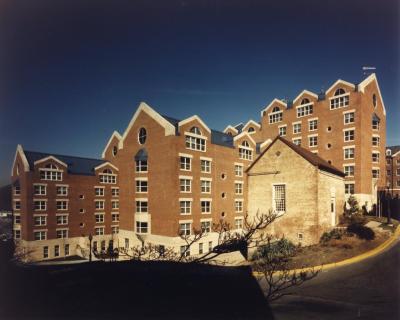Village C West (VCW) and Village C East (VCE), which both house sophomores and upper class students, together form Village C. Village C was completed in September 1987 by Mariani & Associates at a cost of $16,162,104. Spanning 187,026 square feet, Village C was the last in a series of University projects started in 1975 to increase student on-campus housing capacity from 1,500 to 4,100.1 When it opened, Village C provided 660 beds to mostly sophomores and juniors and allowed the University to officially guarantee all students three years of on campus housing.2
Name and facilities
The building was originally named O’Gara Hall for the building it replaced, but the name was changed to Village C soon after completion. In 2018, the University dedicated the former Village C Terrace to Fr. Martin J. O’Gara, the Georgetown faculty member who was killed during WWII while serving as a chaplain in the U.S. Air Force and to whom O’Gara Hall was originally dedicated.3
The Village C first floor houses the Georgetown University Police Department and GERMS (Georgetown Emergency Rescue Medical Society).
Renovations
In 2002, after a call for more student space on campus, the University spent $400,000 renovating the former Village C Formal lounge. Open to all Georgetown students, the renovated space featured two pool tables, a foosball table, a CD jukebox, a 61-inch projection television, couches and chairs, and a snack bar called Jack’s, which was operated by InterHall employees.4 The room was open from open from 2 p.m. until 2 a.m. on weekends, and from 2 p.m. until midnight from Sunday through Thursday. Many a Hoya crowded the room to watch the basketball games on the big screen.5 When the Healey Family Student Center opened in 2014, this space in Village C was all but forgotten.
In 2020, the University gave VCE new bathroom finishes and fixtures, walk in showers, new air handler units, new modular bedroom furniture, new common room furniture, renovated the common rooms and kitchens, and redid the lobby to create additional student and socialization space.6
Notable incidents
Over the years, Village C has suffered its share of unlucky incidents. In 2001, the building was the victim of an arsonist who, in four separate incidents, ignited a message board, two elevators, and wood against the basement door.7 In 2004, a student left a candle unattended next to some papers and her window curtains accidentally causing a fire in an 8th floor room.8 In 2011, a student accidentally fell from her 5th floor window in VCW and suffered an injured spine, broken foot, broken ribs, and a punctured lung. The University responded with a review of all window stops in residential buildings that limit the amount a window may be opened.9
Despite these incidents and the building’s notoriously tall stairs, Village C remains known for its small hill which, at the first sight of snow, becomes packed with students sledding on whatever items they can snag, be it trays “borrowed” from the dining hall to abandoned cardboard boxes.10
- 1Francis X. Ballman, "Village C," Building Outlines Campus Buildings, 1789 – 1995, Father Lawrence Hurley Memorial Edition, Francis X. Ballmann and the Division of Facilities, 1995, p. 97.
- 2Georgetown University (Washington, DC), Ye Domesday Booke, 1987, pp. 104.
- 3Elizabeth Douglas, “Former Village C Terrace Dedicated to Fr. Martin O’Gara, SJ.” The Hoya. 20 April 2018.
- 4Georgetown University (Washington, DC), Ye Domesday Booke, 2002, pp. 45.
- 5Justin Droms, “Multi-Purpose To Open After Break.” The Hoya. 20 Nov. 2001.
- 6“Residential Building Renovations 2020.” https://residentialliving.georgetown.edu/building-renovations/
- 7“Four Cases of Arson in Village C.” The Hoya. 1 Feb. 2001.
- 8Nicole Tingir, “Lit Candle Sparks Village C East Fire.” The Hoya. 3 Sept. 2004.
- 9“Student Falls from Village C West Window.” The Voice. 11 Jan. 2011.
- 10Georgetown University (Washington, DC), Ye Domesday Booke, 2007, pp. 73.


